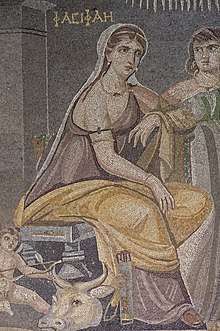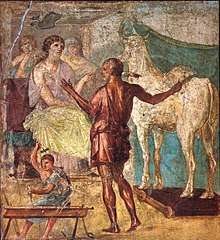Pasiphaë
In Greek mythology, Pasiphaë (/pəˈsɪfəiː/;[1] Greek: Πασιφάη Pasipháē, "wide-shining" derived from πᾶς pas "all, for all, of all" and φάος/φῶς phaos/phos "light")[2] was a queen of Crete.

Family
Pasiphaë was the daughter of Helios, the Titan god of the sun, and Perse,[3] of the Oceanids. [4] Like her doublet Europa, her origins were in the East, in her case at Colchis; she was the sister of Circe, Aeëtes and Perses, and she was given in marriage to King Minos of Crete. With Minos, she was the mother of Acacallis, Ariadne, Androgeus, Glaucus, Deucalion, Phaedra, Xenodice, and Catreus. She was also the mother of "starlike" Asterion, called by the Greeks the Minotaur.

The Minotaur
After a curse from Poseidon, Pasiphaë experienced lust for and mated with a white bull sent by Poseidon.[5] Mythological scholars and authors Ruck and Staples remarked that "the Bull was the old pre-Olympian Poseidon". [6]
In the Greek literalistic understanding of a Minoan myth,[7] in order to actually copulate with the bull, she had the Athenian artificer Daedalus[8] construct a portable wooden cow with a cowhide covering, within which she was able to satisfy her strong desire.[9] This interpretation reduced a near-divine figure (a daughter of the Sun) to a stereotyped emblem of grotesque bestiality and the shocking excesses of lust and deceit.[10] Pasiphaë appeared in Virgil's Eclogue VI (45–60), in Silenus' list of suitable mythological subjects, on which Virgil lingers in such detail that he gives the sixteen-line episode the weight of a brief inset myth.[11] In Ovid's Ars Amatoria Pasiphaë is framed in zoophilic terms: Pasiphae fieri gaudebat adultera tauri—"Pasiphaë took pleasure in becoming an adulteress with a bull."
The Curse of Pasiphaë
In other aspects, Pasiphaë, like her niece Medea, was a mistress of magical herbal arts in the Greek imagination. The author of Bibliotheke (3.197–198) records the fidelity charm she placed upon Minos, who would ejaculate serpents, scorpions, and centipedes killing any unlawful concubine; but Procris, with a protective herb, lay with Minos with impunity.[12]
On divination
In mainland Greece, Pasiphaë was worshipped as an oracular goddess at Thalamae, one of the original koine of Sparta. The geographer Pausanias describes the shrine as small, situated near a clear stream, and flanked by bronze statues of Helios and Pasiphaë. His account also equates Pasiphaë with Ino and the lunar goddess Selene.
Cicero writes in De Divinatione 1.96 that the Spartan ephors would sleep at the shrine of Pasiphaë, seeking prophetic dreams to aid them in governance. According to Plutarch,[13] Spartan society twice underwent major upheavals sparked by ephors' dreams at the shrine during the Hellenistic era. In one case, an ephor dreamed that some of his colleagues' chairs were removed from the agora, and that a voice called out "this is better for Sparta"; inspired by this, King Cleomenes acted to consolidate royal power. Again during the reign of King Agis, several ephors brought the people into revolt with oracles from Pasiphaë's shrine promising remission of debts and redistribution of land.
Possible celestial deity
In Description of Greece, Pausanias equates Pasiphaë with Selene, implying that the figure was worshipped as a lunar deity.[14] However, further studies on Minoan religion indicate that the sun was a female figure, suggesting instead that Pasiphaë was originally a solar goddess, an interpretation consistent with her depiction as Helios' daughter.[15] Poseidon's bull may in turn be vestigial of the lunar bull prevalent in Ancient Mesopotamian religion.[16]
References
- Wells, John C. (2009). "Pasiphae, Pasiphaë". Longman Pronunciation Dictionary. London: Pearson Longman. ISBN 978-1-4058-8118-0.
- An attribute of the Moon, as Pausanias remarked in passing (i.43.96): compare Euryphaessa; if Pasipháē is an ancient conventional Minoan epithet translated into Greek, it would be a "loan translation", or calque.
- Hesiod, Theogony 346.
- Pasiphaë was thus the half-sister of Aeëtes and of Circe. Diodorus Siculus (4.60.4) made the mother of Pasiphaë the island-nymph Crete herself.
- Pseudo-Apollodorus, Bibliotheke 3.1.4
- Ruck and Staples 1994:213.
- Specific astrological or calendrical interpretations of the mystic mating of the "wide-shining" daughter of the Sun with a mythological bull, transformed into an unnatural curse in Hellene myth, are prone to variability and debate.
- Daedalus was of the line of the chthonic king at Athens Erechtheus.
- Greek myth characteristically emphasizes the accursed unnaturalness of a mystical marriage conceived literally as merely carnal: a fragment of Bacchylides alludes to "her unspeakable sickness" and Hyginus (Fabulae 40) to "an unnatural love for a bull".
- This was the commonplace of brief notices of Pasiphaë among Latin poets, too, Rebecca Armstrong notes, in Cretan Women: Pasiphae, Ariadne, and Phaedra in Latin Poetry (Oxford University Press) 2006:169. Armstrong falls into the trap of literalness: in discussing the list of candidates for children of Pasiphaë and Minos, she remarks, "It seems unlikely that Pasiphaë gave birth to these human children after her liaison with the bull" (172 note 9); but there is no chronologically coherent narrative before and after in myth or dream, the aspect of myth that Ruck and Staples (1994:9) call "the suspension of linear chronology", a feature which is remarked upon in all introductions to Greek myth.
- Armstrong 2006:171.
- See also the Metamorphoses of Antoninus Liberalis, 41.
- Plutarch, Lives of Agis and Cleomenes.
- Pasiphae on Theoi.com
- L Goodison, FROM THOLOS TOMB TO THRONE ROOM: PERCEPTIONS OF THE SUN IN MINOAN RITUAL, 02/08/1998
- "Archived copy". Archived from the original on 2015-12-08. Retrieved 2015-11-30.CS1 maint: archived copy as title (link)
Sources
- Kerenyi, Karl. The Gods of the Greeks, 1951.
- Graves, Robert. The Greek Myths, (1955) 1960.
- Ruck, Carl A.P., and Danny Staples, The World of Classical Myth 1994.
- Smith, William; Dictionary of Greek and Roman Biography and Mythology, London (1873). "Past'piiae"
External links
